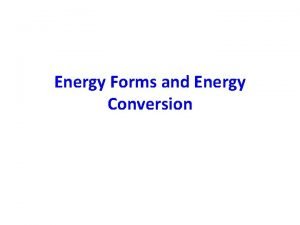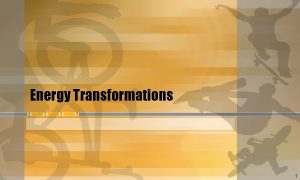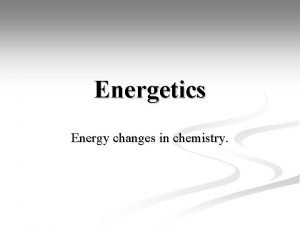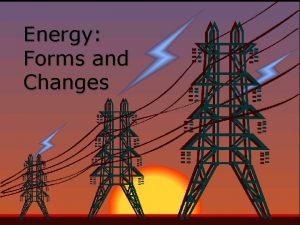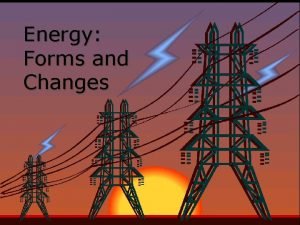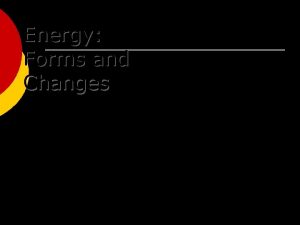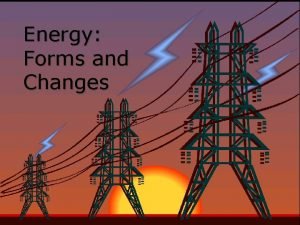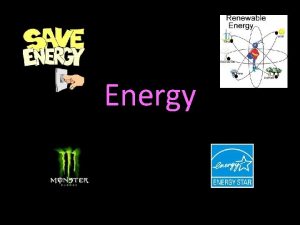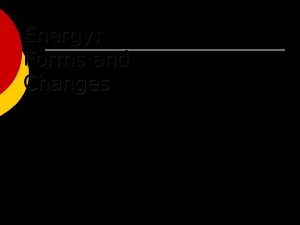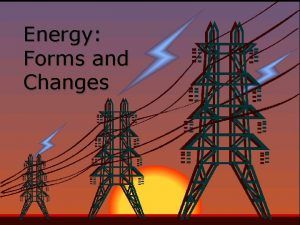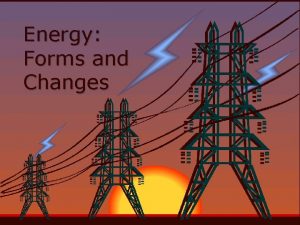Energy Forms and Changes Forms of Energy The















- Slides: 15

Energy: Forms and Changes

Forms of Energy ¡ The five main forms of energy are: Thermal (heat) l Chemical l Electromagnetic (electricity and light) l Nuclear l Mechanical l

Thermal Energy (heat) The internal motion of atoms is called thermal energy, because moving particles produce heat. ¡ Thermal energy can be produced by friction. ¡ Thermal energy causes changes in temperature and phase of any form of matter. ¡

Chemical Energy Chemical energy is required to bond atoms together. ¡ When bonds are broken, energy is released. ¡ Fuel and food are forms of stored chemical energy. ¡

Electromagnetic Energy ¡ Power lines carry electromagnetic energy into your home in the form of electricity.

Electromagnetic Energy ¡ ¡ ¡ Light is a form of electromagnetic energy. Each color of light represents a different amount of electromagnetic energy. Electromagnetic energy is also carried by X-rays, radio waves, and microwaves.

Nuclear Energy ¡ ¡ The nucleus of an atom is the source of nuclear energy. When the nucleus splits (fission), nuclear energy is released in the form of heat energy and light energy.

Mechanical Energy ¡ When work is done to an object, it acquires energy. The energy it acquires is known as mechanical energy.

Mechanical Energy ¡ When you kick a football, you give mechanical energy to the football to make it move.

Energy Conversion ¡ Energy can be changed from one form to another. Changes in the form of energy are called energy conversions.

Energy conversions ¡ All forms of energy can be converted into other forms. l l The sun’s energy through solar cells can be converted directly into electricity. Green plants convert the sun’s energy (electromagnetic) into starches and sugars (chemical energy).

States of Energy The most common energy conversion is the conversion between potential and kinetic energy. ¡ All forms of energy can be in either of two states: ¡ l l Potential – stored energy Kinetic – energy of motion

Kinetic Energy The energy of motion is called kinetic energy. ¡ The faster an object moves, the more kinetic energy it has. ¡

Potential Energy ¡ Potential Energy is stored energy. l l Stored chemically in fuel, the nucleus of atom, and in foods. Or stored because of the work done on it: Stretching a rubber band. ¡ Winding a watch. ¡ Pulling back on a bow’s arrow. ¡ Lifting a brick high in the air. ¡

The Law of Conservation of Energy ¡ Energy can be neither created nor destroyed by ordinary means. l It can only be converted from one form to another.
 Elizabeth mulroney
Elizabeth mulroney Physical and chemical changes examples
Physical and chemical changes examples Energy forms and energy conversions
Energy forms and energy conversions Energy energy transfer and general energy analysis
Energy energy transfer and general energy analysis Energy energy transfer and general energy analysis
Energy energy transfer and general energy analysis Calculation of enthalpy
Calculation of enthalpy Changing forms of energy
Changing forms of energy Energy changes
Energy changes What is thermochemistry
What is thermochemistry Hát kết hợp bộ gõ cơ thể
Hát kết hợp bộ gõ cơ thể Lp html
Lp html Bổ thể
Bổ thể Tỉ lệ cơ thể trẻ em
Tỉ lệ cơ thể trẻ em Gấu đi như thế nào
Gấu đi như thế nào Chụp phim tư thế worms-breton
Chụp phim tư thế worms-breton Alleluia hat len nguoi oi
Alleluia hat len nguoi oi


